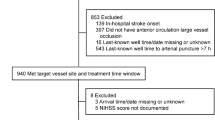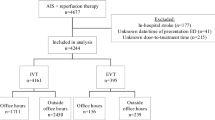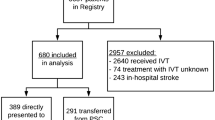Abstract
Background
As intravenous thrombolysis frequently fails to recanalize occluded proximal intracerebral arteries, interventional recanalization therapy is increasingly being considered as treatment option in acute ischemic stroke patients. The optimal periprocedural patient management for these interventions is currently unknown. The aim of this study was to identify factors delaying door-to-treatment times, and to evaluate the effect of a fast-track intubation standard operating procedure (I-SOP) on door-to-angiography time.
Methods
First, we retrospectively reviewed records of 48 acute stroke patients who were treated by interventional recanalization of intracranial occlusions between 2006 and 2009 at our institution. Time to angiography was defined as time from hospital admission to the beginning of the angiographic procedure. Second, an I-SOP for fast-track intubation was implemented and effects on door-to-angiography time were prospectively analyzed in 23 consecutive patients.
Results
In the retrospective dataset (n = 48), the mean door-to-angiography time was 2.2 ± 0.1 h (mean ± SEM). A clinically relevant time loss attributable to the intubation procedure was suggested by a 51 ± 21 min shorter door-to-angiography time for patients already intubated prior to admission (P = 0.0189). Additional factors associated with a prolonged door-to-angiography time were: door-to-diagnosis time (P < 0.001), onset-to-door time (P = 0.0117), and male gender (mean difference +27 ± 15 min, P = 0.0822). In the prospective dataset (n = 23), I-SOP implementation reduced mean door-to-angiography time by 25 ± 10 min (P = 0.0164).
Conclusions
In acute stroke patients, intubation prior to interventional recanalization therapy can delay treatment initiation. The implementation of an I-SOP accelerates interventional treatment initiation.


Similar content being viewed by others
References
Rha JH, Saver JL. The impact of recanalization on ischemic stroke outcome: a meta-analysis. Stroke. 2007;38:967–73.
Lees KR, Bluhmki E, von Kummer R, Brott TG, Toni D, Grotta JC, Albers GW, Kaste M, Marler JR, Hamilton SA, Tilley BC, Davis SM, Donnan GA, Hacke W, Allen K, Mau J, Meier D, del Zoppo G, De Silva DA, Butcher KS, Parsons MW, Barber PA, Levi C, Bladin C, Byrnes G. Time to treatment with intravenous alteplase and outcome in stroke: an updated pooled analysis of ECASS, ATLANTIS, NINDS, and EPITHET trials. Lancet. 2010;375:1695–703.
Khatri P, Abruzzo T, Yeatts SD, Nichols C, Broderick JP, Tomsick TA. Good clinical outcome after ischemic stroke with successful revascularization is time-dependent. Neurology. 2009;73:1066–72.
Koennecke HC, Nohr R, Leistner S, Marx P. Intravenous tPA for ischemic stroke team performance over time, safety, and efficacy in a single-center, 2-year experience. Stroke. 2001;32:1074–8.
Lindsberg PJ, Happola O, Kallela M, Valanne L, Kuisma M, Kaste M. Door to thrombolysis: ER reorganization and reduced delays to acute stroke treatment. Neurology. 2006;67:334–6.
Mehdiratta M, Woolfenden AR, Chapman KM, Johnston DC, Schulzer M, Beckman J, Teal PA. Reduction in IV t-PA door to needle times using an acute stroke triage pathway. Can J Neurol Sci. 2006;33:214–6.
The European Stroke Organisation (ESO) Executive Committee and the ESO Writing Committee. Guidelines for management of ischaemic stroke and transient ischaemic attack. Cerebrovasc Dis. 2008;25:457–507.
Saver JL, Smith EE, Fonarow GC, Reeves MJ, Zhao X, Olson DM, Schwamm LH. The “Golden hour” and acute brain ischemia: presenting features and lytic therapy in >30,000 patients arriving within 60 minutes of stroke onset. Stroke. 2010;41:1431–9.
Tveiten A, Mygland A, Ljostad U, Thomassen L. Intravenous thrombolysis for ischaemic stroke: short delays and high community-based treatment rates after organisational changes in a previously inexperienced centre. Emerg Med J. 2009;26:324–6.
Furlan A, Higashida R, Wechsler L, Gent M, Rowley H, Kase C, Pessin M, Ahuja A, Callahan F, Clark WM, Silver F, Rivera F, Investigators P. Intra-arterial prourokinase for acute ischemic stroke—the PROACT II study: a randomized controlled trial. JAMA. 1999;282:2003–11.
Shi ZS, Loh Y, Walker G, Duckwiler GR. Endovascular thrombectomy for acute ischemic stroke in failed intravenous tissue plasminogen activator versus non-intravenous tissue plasminogen activator patients: revascularization and outcomes stratified by the site of arterial occlusions. Stroke. 2010;41:1185–92.
Investigators IIT. The interventional management of stroke (IMS) II study. Stroke. 2007;38:2127–35.
Nedeltchev K, Arnold M, Brekenfeld C, Isenegger J, Remonda L, Schroth G, Mattle HP. Pre- and in-hospital delays from stroke onset to intra-arterial thrombolysis. Stroke. 2003;34:1230–4.
Tountopoulou A, Ahl B, Weissenborn K, Becker H, Goetz F. Intra-arterial thrombolysis using rt-PA in patients with acute stroke due to vessel occlusion of anterior and/or posterior cerebral circulation. Neuroradiology. 2008;50:75–83.
Kamper L, Rybacki K, Mansour M, Winkler SB, Kempkes U, Haage P. Time management in acute vertebrobasilar occlusion. Cardiovasc Intervent Radiol. 2009;32:226–32.
ESO-guidelines. http://www.Eso-stroke.Org/pdf/eso%20guidelines_update_jan_2009.Pdf (2009).
The IMS Study Investigators. Combined intravenous and intra-arterial recanalization for acute ischemic stroke. The interventional management of stroke study. Stroke. 2004;35:904–11.
Lewandowski CA, Frankel M, Tomsick TA, Broderick J, Frey J, Clark W, Starkman S, Grotta J, Spilker J, Khoury J, Brott T. Combined intravenous and intra-arterial r-tPA versus intra-arterial therapy of acute ischemic stroke: emergency management of stroke (EMS) bridging trial. Stroke. 1999;30:2598–605.
Nagel S, Schellinger PD, Hartmann M, Juettler E, Huttner HB, Ringleb P, Schwab S, Kohrmann M. Therapy of acute basilar artery occlusion: intraarterial thrombolysis alone vs bridging therapy. Stroke. 2009;40:140–6.
Abou-Chebl A, Lin R, Hussain MS, Jovin TG, Levy EI, Liebeskind DS, Yoo AJ, Hsu DP, Rymer MM, Tayal AH, Zaidat OO, Natarajan SK, Nogueira RG, Nanda A, Tian M, Hao Q, Kalia JS, Nguyen TN, Chen M, Gupta R. Conscious sedation versus general anesthesia during endovascular therapy for acute anterior circulation stroke: preliminary results from a retrospective, multicenter study. Stroke. 2010;41:1175–9.
Acknowledgments
This study was supported by a grant from the Else Kroener Fresenius Stiftung to RV. We thank the physicians and the nursing staff of our department for cooperation.
Conflict of interest
Oliver Herrmann, Andreas Hug, Julian Bösel, Juliana Johanna Petersen, Marius Hartmann, Stefan Rohde, Martin Bendszus, Peter Arthur Ringleb, Werner Hacke, and Roland Veltkamp have no conflicts of interest concerning this study.
Author information
Authors and Affiliations
Corresponding author
Additional information
Andreas Hug and Oliver Herrmann contributed equally to this work.
Rights and permissions
About this article
Cite this article
Herrmann, O., Hug, A., Bösel, J. et al. Fast-Track Intubation for Accelerated Interventional Stroke Treatment. Neurocrit Care 17, 354–360 (2012). https://doi.org/10.1007/s12028-012-9671-7
Published:
Issue Date:
DOI: https://doi.org/10.1007/s12028-012-9671-7




